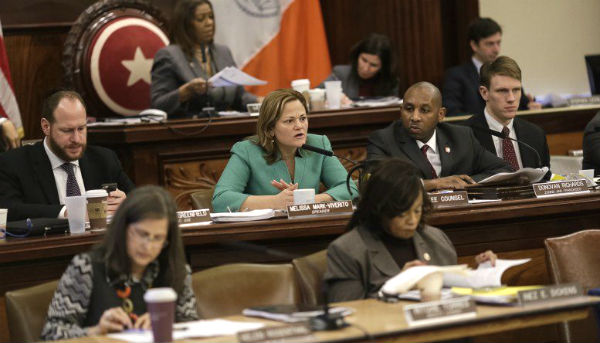 Several protesters glued their hands together and chanted loudly in opposition to Mayor Bill de Blasio’s two big zoning policies yesterday at City Hall, but the City Council still passed the two affordable housing proposals, Mandatory Inclusionary Housing (MIH) and Zoning for Quality and Affordability (ZQA), with little opposition.
Several protesters glued their hands together and chanted loudly in opposition to Mayor Bill de Blasio’s two big zoning policies yesterday at City Hall, but the City Council still passed the two affordable housing proposals, Mandatory Inclusionary Housing (MIH) and Zoning for Quality and Affordability (ZQA), with little opposition.
MIH and ZQA—both of which were designed to boost affordable housing development—passed the City Council with flying colors. Members approved MIH 42 to 5, and ZQA passed with a vote of 40 to 6, with one abstention. The members who opposed the measures fell at opposite ends of the spectrum.
Inez Barron and Jumaane Williams, both Democrats representing central and eastern Brooklyn, said MIH simply didn’t serve the low-income, largely black and Latino communities in their districts. Williams has repeatedly said the inclusionary housing won’t do enough to address New York City’s racially segregated neighborhoods.
Two Republicans from Staten Island, Joe Borelli and Steven Matteo, voted against the policies. The island is the slowest growing and the most car-dependent of the five boroughs, along with being notoriously anti-development. Since Staten Island is zoned mostly for the construction of one- and two-family homes, the borough’s elected officials fight tooth and nail against extra height for new buildings. And the island’s lack of public transportation generally means that any reduction in parking requirements is a non-starter.
Six vocal activists interrupted the vote while Council Member Margaret Chin was explaining why she supported the two plans. After they refused to stop yelling, “City council vote no, MIH has got to go,” security officers tried to escort them from the City Council chambers.
Harlem Council Speaker Melissa Mark-Viverito (pictured) called a recess for the vote and announced that staff had called an ambulance for the injured protester.
The whole procedure took several minutes because the protesters were glued together, and one protester was injured in the process. As they hauled the activists from the upper balcony of the hearing room, one protester fell to the ground, injured. Meanwhile, Harlem Council Speaker Melissa Mark-Viverito (pictured) called a recess for the vote and announced that staff had called an ambulance for the injured protester. When EMTs finally took the man away in a wheelchair, the proceedings cranked forward.
MIH and ZQA were created to prop up the mayor’s ambitious housing plan, which calls for building 80,000 affordable apartments in next decade. Under MIH, any developer who wants to build on rezoned land will have to rent 20 to 30 percent of their apartments at below-market rates. Builders will be able to choose from four income bands for the affordable units, ranging from 40 to 115 percent of the Area Median Income. However, the City Council member in whose district the development site sits will ultimately decide the affordable set-asides for new buildings.
When the council’s Land Use Committee approved the plans last week, they rolled out the new, low-income option for MIH. It would require a developer to rent 20 percent of a building’s units to families making up to 40 percent AMI, or $31,000 a year for a three-person household.
We won’t unpack all of the changes that the council made to MIH, which DNAinfo covered in great detail. Another notable change calls for developers to rent 10 percent of their units at 40 percent AMI if they’re building under the option that requires 25 percent of the apartments to go to households making an average of 60 percent AMI.
Originally, all new buildings would have the option of including an extra five feet on the ground floor, to encourage better retail. That measure was eliminated in Manhattan south of 125th Street.
ZQA aims to loosen height caps and parking requirements for senior and affordable projects. But the City Council has scaled back many of the ambitious changes included when the policy was first rolled out a year ago. Originally, all new buildings would have the option of including an extra five feet on the ground floor, to encourage better retail. That measure was eliminated in Manhattan south of 125th Street.
Most zoning districts were also going to get a bump in allowable heights for new construction. The Council cut the height bonuses in certain low-density parts of the outer boroughs.
Lastly, ZQA originally eliminated parking requirements for senior and affordable projects with in a half mile of the subway – what the city calls the transit zone. Council members in parts of the outer boroughs successfully argued that pieces of their districts should be eliminated from the transit zone because they didn’t include adequate transit, despite being within half a mile of the train.
Via Yimby
Become a Harlem Insider!
By submitting this form, you are consenting to receive marketing emails from: . You can revoke your consent to receive emails at any time by using the SafeUnsubscribe® link, found at the bottom of every email. Emails are serviced by Constant Contact








